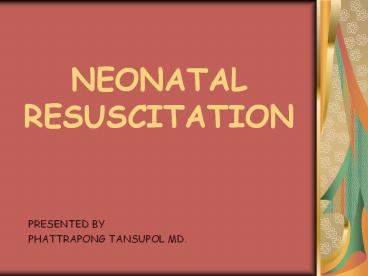NEONATAL RESUSCITATION - PowerPoint PPT Presentation
1 / 28
Title: NEONATAL RESUSCITATION
1
NEONATAL RESUSCITATION
- PRESENTED BY
- PHATTRAPONG TANSUPOL MD.
2
????????????????????????????????????????????????
- 1.???????????????????
- 2.????????
- 3.???????????????
- 4.ACTION/EVALUATION/DECISION CYCLE
- 5.????????????????? ??????????????
3
ACTION/EVALUATION/DECISION CYCLE
- EVALUATION
- ACTION DECISION
4
ASPHYXIA THE BASIC
- 1.Primary Apnea When asphyxiated, the infant
responds with a increased RR. If the episode
continues, the infant becomes apnic, followed by
a drop in HR and a slight increase in BP.The
infant will respond to stimulation and therapy
with spontaneous respirations.
5
- 2. Secondary apnea after primary apnea, the
infant responds with a period a gasping
respirations, falling HR, and falling BP.The
infant takes a last breath and then enters the
secondary apnea period.The infant will not
respond to stimulation and death will occur
unless resuscitation begins immediately. - Because after delivery of an infant it is
impossible to differentiate between primary apnea
and secondary apnea, assume the infant is in
secondary apnea and begin resuscitation
immediately.
6
ASPHYXIA CHANGE
7
APGAR SCORE
8
Anticipation and Recognition of the Neonate in
Distress 1.Antepartum and intrapartum history
9
1.Antepartum and intrapartum history CONT.
10
Equipment
- Equipment and medications should be checked as a
daily routine and then prior to anticipated need.
Used items should be replenished as soon as
possible after a resuscitation. - The delivery room should be kept relatively warm
and the radiant heater should be preheated when
possible. Prewarming of towels and blankets can
also be helpful in preventing excessive heat loss
from the neonate.
11
Equipment
- SUCTION EQUIPMENT
- BULB SYRINGE
- SUCTION CATH NO 5 6 8 10 Fr
- 8 Fr FEEDING TUBE 20 ml SYRINGE
- MECONIUM ASPIRATOR
- BAG-MASK EQUIPMENT
- FACE MASK
- ORAL AIRWAY
- OXYGEN
12
Equipment CONT.
- INTUBATION EQUIPMENT
- LARYNGOSCOPY-BLADE NO 0-1
- BATTERY FOR LARYNGOSCOPE
- ETT NO 2.5 3.0 3.5 4.0 mm
- STYLET SCISSOR GLOVE
- MISCELLANEOUS
- RADIANT WARMER-STETHOSCOPE-TAPE-
- SYRINGE-NEEDLE-ALCOHOL-UMBILICAL CATH
13
Initial Steps for Neonatal Resuscitation in
Delivery Room
- ANTICIPATION
- ASSESSMENT OF ACTION
- 1.PREVENT HEAT LOSS
- Place the infant under an overhead radiant heater
to minimize radiant and convective heat loss. - Dry the body and head to remove amniotic fluid
and prevent evaporative heat loss. This will also
provide gentle stimulation to initiate or help
maintain breathing.
14
Initial Steps for Neonatal Resuscitation in
Delivery Room CONT.
- 2.ABCDE STEP
- A-AIRWAY
- POSITION
- CLEAR AIRWAY-SUCTION MOUTH THEN NOSE
15
Initial Steps for Neonatal Resuscitation in
Delivery Room CONT.
- B-BREATHING ADEQUACY
- 1.TACTILE STIMULATION
- slapping or flicking the soles of the feet
- rubbing the back gently
- Do not waste time continuing tactile stimulation
if there is no response after 10 - 15 seconds. - 2.FREE FLOW OXYGEN 3.PPV
16
Initial Steps for Neonatal Resuscitation in
Delivery Room CONT.
- C-CARDIOVASCULAR RESUSCITATION
- D-DRUG
- -DIAGNOSIS
- E-ENVIRONMENT
- -EXTENDED CARE
17
Resuscitation in the delivery room
18
PPV
- 1.INDICATION FOR PPV
- APNEA OR GASPING
- HR lt 100 bpm
- CENTRAL CYANOSIS
- 2.BAG-Self inflating vs. flow dependent bag
- 3. Rate 40-60 bpm
- 4. Pressure used
- a. Initial breath after delivery 30-40 cm
H2O b. Normal delivery 15-20 cm
H2O c. Diseased Lungs 20-40 cm H2O
19
PPV CONT.
- 5. Technique/Trouble shooting problems of Bag
mask ventilation - a. Check for a good seal b. Check for a
patent airway c. Are you using enough
pressure ? - 6.Checking for chest movement
- check mask position
- head position-hyperflexion or hyperextention
- secretion obstruction
- slighly open infant mount
- checking for pressure
20
Chest compression
- 1. Indications
- If after 15-30 seconds of positive pressure
ventilation with 100 FIO2 the heart rate is - a. below 60 bpm b.between 60-80 bpm and not
increasing - 2. Technique a. 1 fingers breadth below nipple
line, using 2 fingers b. 1/2 to 3/4
compression depth c. accompanied by
ventilations, ratio is 31
21
METHOD
22
ENDOTRACHEAL TUBE INTUBATION
- 1.Indications for intubation
- a. Prolonged bag and mask ventilation
b. Bag and mask is ineffective c.
Tracheal suctioning - 2.Tube size
- Tube size Weight Gestational Age
(ID mm) (gm) (weeks) - 2.5 lt1000 lt28
- 3.0 1000-2000 28-34
- 3.5 2000-3000 34-38
- 3.5-4.0 gt3000 gt38
23
????????????????????????????????????????
- 1.???????????????????????? 2 ????
- 2.??????????????????????????????????
- 3.??????????????????????? 2 ????
24
MEDITATION
- 1.Indication
- HR lt 80 bpm despite 100 O2 and chest compression
30 sec - No heart rate
25
- Drug
- -adrenaline
- -volume expander
- -NaHCO3
- -Dopamine
- -Naloxone hydrochloride
26
Drug dosage
27
Drug dosage cont.
28
??????????????????????????
- 1.inadequate ventilation missplaced
ETT,inadequate pressure,air leak syndrome - 2.Shoke asphyxia,hypovolumic,septic
- 3.Congenital anomalies pulmonary
hypoplasia,severe cardiac disease
29
- THE END
- Thank you































